Ceramics Manufacturer Financial Model
Here’s a comprehensive breakdown of an Excel template Ceramics Manufacturer Financial Model, covering the Income Statement, Cash Flow Statement, and Balance Sheet. With revenues from 80 product lines and a Subscription Add-On. Cost structures and financial statements to forecast the financial health of your Ceramics company.
Financial Model for a Ceramics Manufacturer
Covering key components such as the Income Statement, Cash Flow Statement, and Balance Sheet.
Income Statement
Revenue Streams
- Component Sales:
- Sales of ceramic manufactured parts, segmented into custom and standard product categories.
- Custom: High-margin niche products for bespoke client requirements.
- Standard: Regular production parts for repeat orders (e.g., Alumina, Silicon Nitride, Zirconia).
- Sales of ceramic manufactured parts, segmented into custom and standard product categories.
- Recurring Services Revenue:
- Maintenance contracts, and calibration of automotive, medical and consumer electronics sectors.
- Tiered subscription revenue for design optimization and supply chain integration.
- Tooling & Setup Fees:
- One-time charges for creating ceramic data sheets and applications required for custom designs.
- After-Sales Support:
- Revenue from servicing ceramic parts and selling add-ons.
Expenses
- COGS:
- Raw Materials: energy for high-temperature processes, plastics, composites used in manufacturing.
- Direct Labor: Skilled machinists and operators.
- Overheads: Depreciation of machinery, utility costs, and maintenance.
- Operating Expenses:
- R&D: Development of more efficient manufacturing techniques.
- Sales & Marketing: Promoting services to industries and maintaining client relationships.
- Administrative: Salaries, office expenses, and ERP software.
- Other Expenses:
- Regulatory and compliance costs for different industries (ISO certifications).
Profitability Metrics
- Gross Profit: Revenue – COGS.
- EBITDA: Gross Profit – Operating Expenses.
- Net Income: EBITDA – Taxes – Interest.
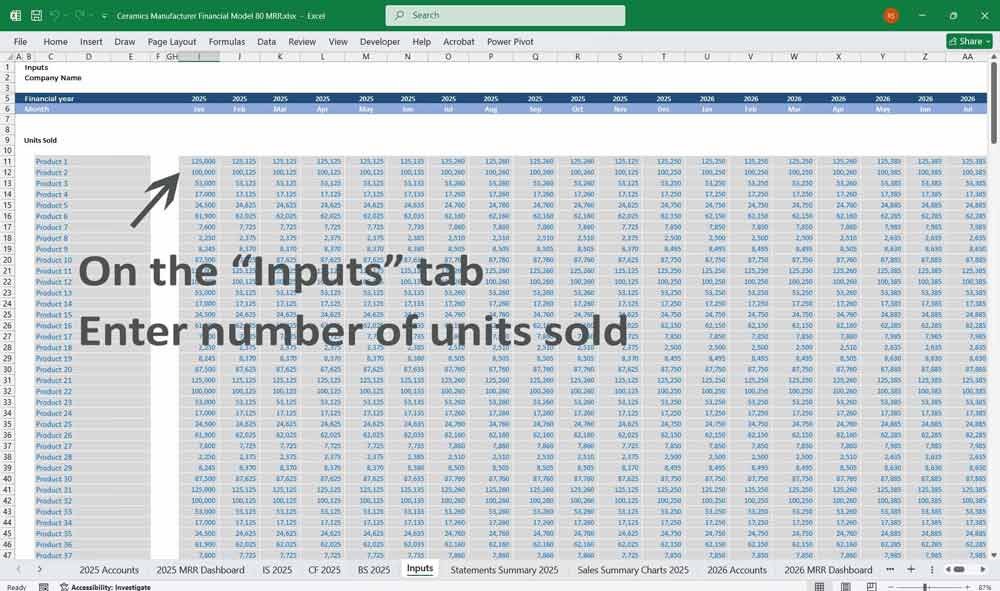
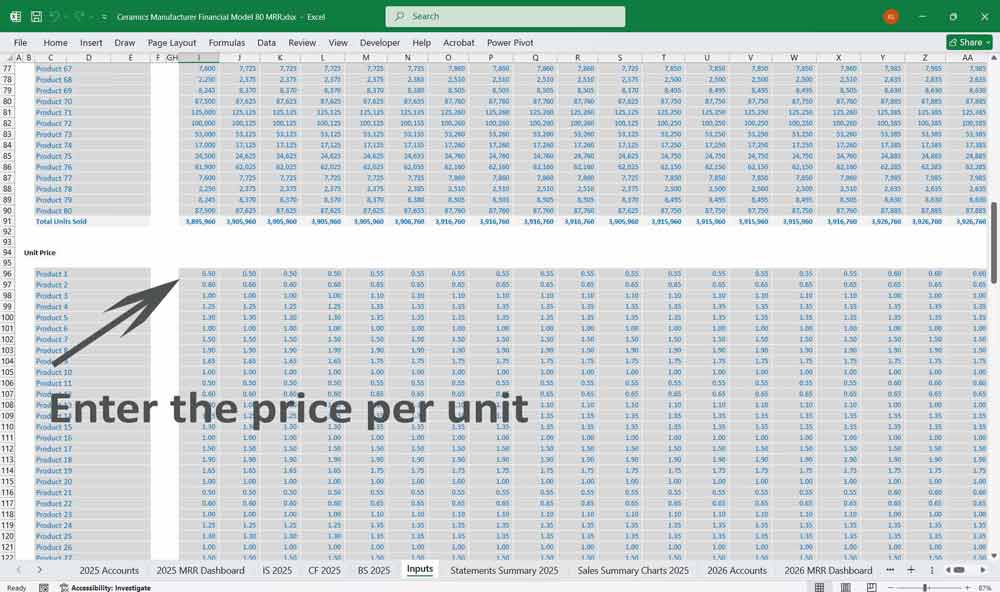
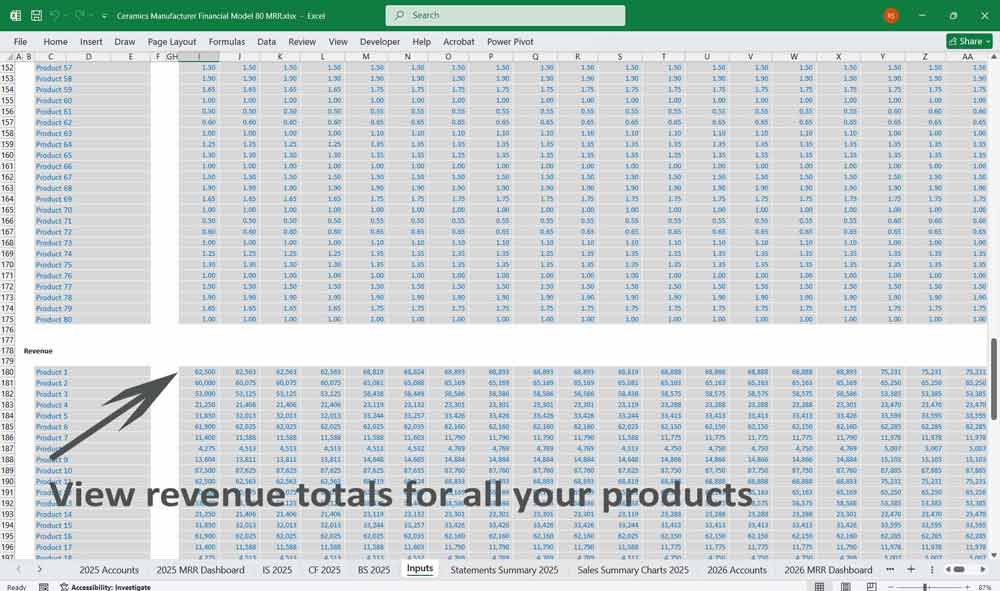
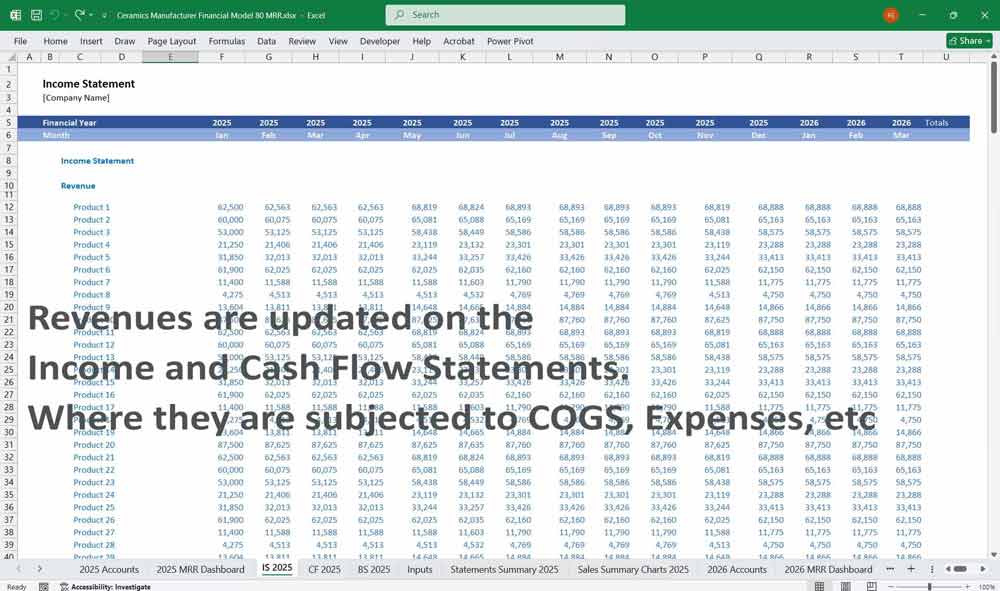
Ceramics Manufacturer Cash Flow Statement
Operating Activities
- Inflows:
- Payments received for ceramic products and subscription services.
- Advance payments for tooling and custom jobs.
- Regular recurring revenue from Tier 6 subscriptions.
- Outflows:
- Raw material procurement and supplier payments.
- Wages for machinists, designers, and administrative staff.
- Overhead payments (utilities, maintenance, and insurance).
Investing Activities
- Inflows:
- Disposal of old machinery or surplus raw material inventory.
- Outflows:
- Purchases of new ceramic machines for expanded product capacity.
- Development of proprietary software for faster production.
Financing Activities
- Inflows:
- Equity injections for capacity expansion.
- Debt financing for production line upgrades.
- Outflows:
- Loan repayments.
- Dividend payments.
Key Metrics
- Free Cash Flow (FCF): Operating Cash Flow – Capital Expenditures.
- Operating Cash Conversion: Measures the efficiency of turning revenue into usable cash.
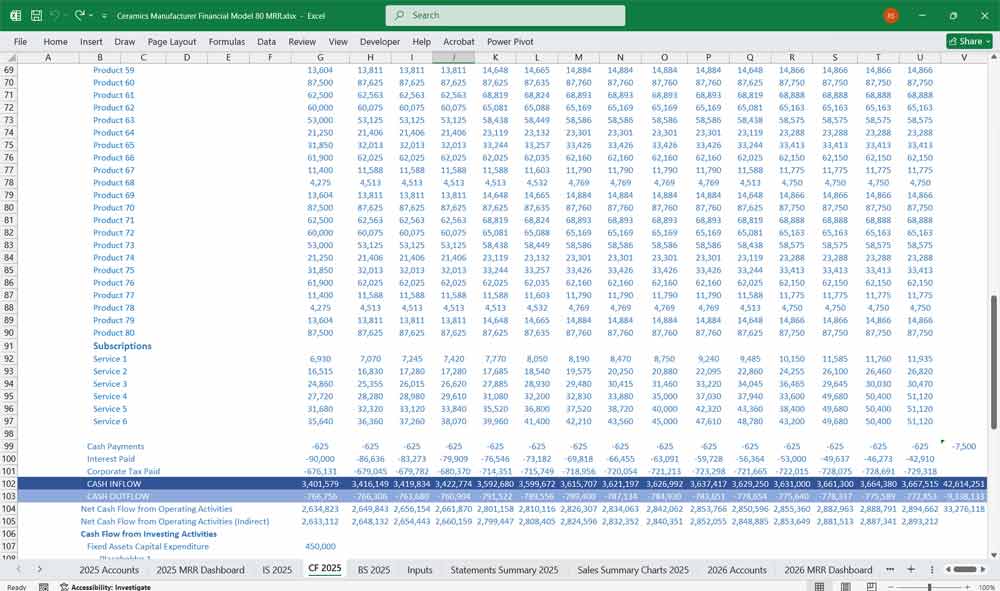
Ceramics Manufacturer Balance Sheet
Assets
- Current Assets:
- Cash reserves for operational continuity.
- Accounts receivable from industrial clients.
- Inventory of raw materials, semi-finished goods, and finished products.
- Non-Current Assets:
- Injection machines, molds, and tooling setups.
- Intangible assets like software licenses for programming.
Liabilities
- Current Liabilities:
- Payables to suppliers.
- Accrued expenses for wages, utilities, and deferred subscriptions.
- Non-Current Liabilities:
- Long-term loans for expansion and machine upgrades.
Equity
- Retained earnings are reinvested into growth.
- Share capital raised for technology and product diversification.
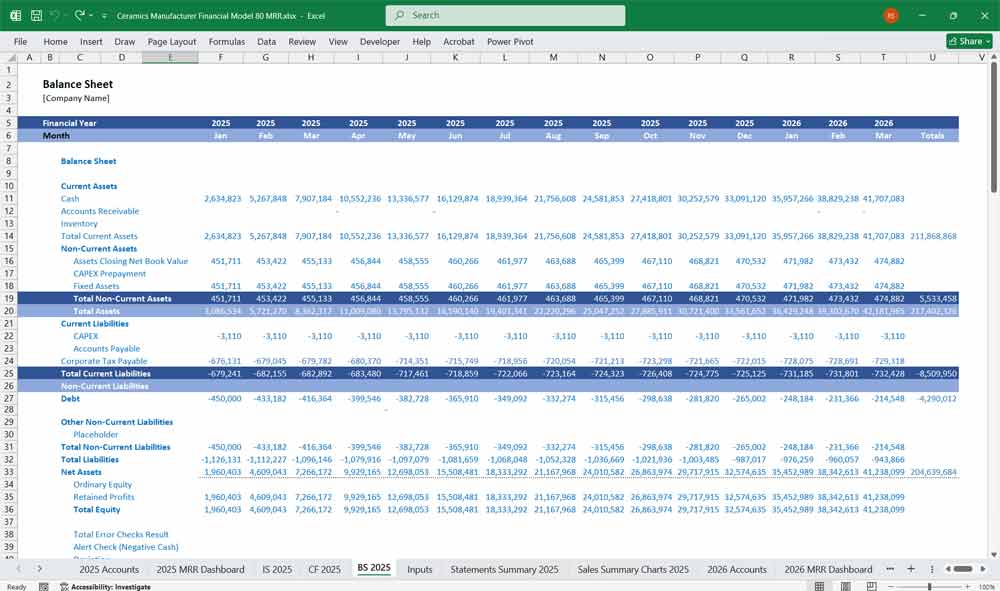
Key Financial Metrics for a Ceramics Manufacturer
- Gross Profit Margin = (Gross Profit / Revenue) × 100
- Operating Profit Margin (EBIT Margin) = (EBIT / Revenue) × 100
- Net Profit Margin = (Net Income / Revenue) × 100
- Return on Assets (ROA) = (Net Income / Total Assets) × 100
- Return on Equity (ROE) = (Net Income / Shareholder Equity) × 100
- Debt-to-Equity Ratio = (Total Debt / Shareholder Equity)
- Inventory Turnover = (COGS / Average Inventory)
- Days Sales Outstanding (DSO) = (Accounts Receivable / Revenue) × 365
When structuring product lines for a ceramics manufacturer, it’s important to organize them in a way that aligns with customer needs, market demand, and operational efficiency. Below are detailed sections for 80 product lines, including categorization, examples, and strategic considerations.
40 Product Lines for a Ceramics Manufacturer
This structure focuses on a more concise range of product lines, suitable for a mid-sized ceramics manufacturer.
1. 40-Product Line Breakdown
1. Tableware Ceramics
Dinner Plate Ceramics
Salad Plate Ceramics
Ceramics Bowls (Soup, Rice, Cereal)
Ceramics Mugs and Cups
Ceramics Teacups and Saucers
Serving Platter Ceramics
Serving Bowl Ceramics
Butter Dishes and Condiment Set Ceramics
2. Kitchenware Ceramics
Ceramics Baking Dishes (Casseroles, Ramekins)
Ceramics Mixing Bowls
Ceramics Measuring Cups and Spoons
Ceramics Canisters and Storage Jars
Ceramics Mortar and Pestle Sets
Ceramics Trivets and Coasters
3. Ceramics Decorative Items
Vases (Floor, Tabletop, Mini) Ceramics
Decorative Bowl Ceramics
Figurines and Sculptures
Wall Art and Ceramic Tile
Ceramic Candle Holders
Planters and Pot Ceramic
4. Ceramic Tiles
Ceramic Floor Tiles
Ceramic Wall Tiles
Mosaic Ceramic Tiles
Outdoor Ceramic Tiles
Custom Ceramic Design Tiles
5. Ceramic Sanitaryware
Ceramic Toilets
Ceramic Wash Basins
Bidet Ceramic
Shower Tray Ceramic
Ceramic Bathroom Accessories (Soap Dishes, Toothbrush Holders)
6. Specialty Ceramic Items
Ceramic Jewelry
Ceramic Lighting Fixtures
Ceramic Musical Instruments (Ocarinas, Wind Chimes)
Ceramic Table Legs and Furniture Accents
7. Industrial Ceramics
Ceramic Insulators
Laboratory Ceramic Ware (Crucibles, Beakers)
Grinding Ceramic Media
Ceramic Coatings
8. Custom and Artisanal Ceramic Lines
Hand-Painted Ceramics
Ceramic Custom Commissions
80 Product Line Breakdown
This expanded structure includes more specialized and niche product lines, catering to a broader market.
1. Tableware Ceramic
Ceramic Dinner Plates
Ceramic Salad Plates
Dessert Plates
Bread and Butter Plates
Soup Bowl Ceramics
Rice Bowls
Ceramic Cereal Bowls
Ceramic Mugs
Coffee Cups
Teacups and Saucers
Serving Platter Ceramics
Ceramic Serving Bowls
Butter Dishes
Condiment Sets
Ceramic Gravy Boats
Ceramic Egg Cups
2. Ceramic Kitchenware
Baking Dishes (Casseroles, Ramekins)
Ceramic Mixing Bowls
Measuring Cup Ceramics
Ceramic Measuring Spoons
Canisters
Storage Jars
Ceramic Mortar and Pestle Sets
Trivets
Ceramic Coasters
Ceramic Utensil Holders
Knife Blocks
Ceramic Salt and Pepper Shakers
3. Ceramic Decorative Items
Floor Vase Ceramics
Tabletop Vases
Mini Vase Ceramic
Ceramic Decorative Bowls
Figurines
Sculptures
Ceramic Wall Art
Ceramic Tiles (Decorative)
Candle Holder Ceramics
Planters
Ceramic Pots
Bookends
Ceramic Paperweights
Ceramic Clocks
4. Ceramic Tiles
Ceramic Floor Tiles
Wall Tiles
Ceramic Mosaic Tiles
Ceramic Outdoor Tiles
Custom Design Tiles
Subway Ceramic Tiles
Geometric Ceramic Tiles
Textured Ceramic Tiles
Glazed Ceramic Tiles
Unglazed Ceramic Tiles
5. Ceramic Sanitaryware
Toilets
Ceramic Wash Basins
Bidets
Shower Ceramic Trays
Bathroom Accessories (Soap Dishes, & Ceramic Toothbrush Holders)
Towel Racks
Ceramic Toilet Brush Holders
Ceramic Shower Wall Panels
6. Specialty Ceramic Items
Ceramic Jewelry (Earrings, Necklaces)
Ceramic Lighting Fixtures (Lamps, Pendant Lights)
Ceramic Musical Instruments (Ocarinas, Wind Chimes)
Ceramic Table Legs
Furniture Accents
Ceramic Buttons
Ceramic Knobs (for Cabinets and Doors)
Ceramic Chess Sets
7. Industrial Ceramics
Insulators
Laboratory Ware (Ceramic Crucibles, Beakers)
Grinding Media
Ceramic Coatings
Ceramic Filters
Ceramic Membranes
Ceramic Bearings
Ceramic Cutting Tools
8. Custom and Ceramic Artisanal Lines
Hand-Painted Ceramics
Custom Commissions
Limited Edition Collections
Collaborative Artist Series
Conclusion
This 40 & 80 product line breakdown provides a detailed view of the ceramics manufacturing industry, categorizing products by construction, automotive, consumer, industrial, and decorative applications
6-tier subscription model for a ceramics manufacturer
Cater to a wide range of customers, from casual buyers to serious collectors or businesses. Each tier should offer increasing value, exclusivity, and benefits to justify the higher price points.
1. Basic Tier: “Casual Ceramic Collector”
Target Audience: Casual buyers, beginners, or those who appreciate ceramics but don’t want to commit to a high-cost subscription.
Price: Low-cost (e.g., 10–10–20/month).
Features:
Monthly Ceramic Piece: One small, functional ceramic item (e.g., a mug, small bowl, or coaster).
Discounts: 10% off all purchases on the website.
Exclusive Content: Access to a monthly newsletter with ceramic care tips, DIY projects, and behind-the-scenes content.
Community Access: Entry into a basic online community forum for ceramic enthusiasts.
Free Shipping: On subscription items only.
2. Intermediate Tier: “Home Ceramic Enthusiast”
Target Audience: Homeowners or renters looking to enhance their living spaces with ceramics.
Price: Mid-range (e.g., 30–30–50/month).
Features:
Monthly Ceramic Set: A curated set of 2–3 items (e.g., a matching mug and plate, or a decorative vase and coaster set).
Discounts: 15% off all purchases on the website.
Exclusive Content: Access to video tutorials on styling ceramics in home decor.
Community Access: Entry into an exclusive Facebook group or Discord server for home decor tips.
Free Shipping: On all orders, not just subscription items.
Early Access: Early access to new product launches.
3. Premium Tier: “Ceramic Art Lover”
Target Audience: Art enthusiasts and collectors who appreciate unique, handcrafted ceramics.
Price: Higher mid-range (e.g., 60–60–100/month).
Features:
Monthly Artisan Piece: One handcrafted, limited-edition ceramic item (e.g., a sculptural vase, artisanal bowl, or decorative figurine).
Discounts: 20% off all purchases on the website.
Exclusive Content: Monthly virtual studio tours or Q&A sessions with ceramic artists.
Community Access: VIP access to exclusive events (e.g., virtual gallery openings).
Free Shipping: On all orders, including international shipping.
Personalization: Option to customize colors or designs for certain pieces.
Gift Option: Ability to gift a subscription to someone else.
4. Professional Tier: “Designer’s Ceramic Choice”
Target Audience: Interior designers, architects, or businesses looking for high-quality ceramics for projects.
Price: High-range (e.g., 150–150–300/month).
Features:
Monthly Professional Pack: A curated collection of 5–7 high-end ceramic pieces (e.g., tiles, decorative items, or tableware).
Discounts: 25% off all purchases on the website.
Exclusive Content: Access to a library of design resources (e.g., CAD files, mood boards, and trend reports).
Community Access: Invitations to exclusive trade shows or industry events.
Free Shipping: On all orders, including expedited shipping.
Customization: Tailored ceramic pieces to match specific project requirements.
Consultation: Monthly 1:1 consultation with a ceramic design expert.
5. Luxury Tier: “Connoisseur’s Ceramic Collection”
Target Audience: High-net-worth individuals or serious collectors seeking rare and exclusive ceramics.
Price: Premium (e.g., 500–500–1,000/month).
Features:
Monthly Masterpiece: One rare, museum-quality ceramic piece created by renowned artists.
Discounts: 30% off all purchases on the website.
Exclusive Content: Private virtual tours of ceramic art exhibitions or artist studios.
Community Access: Membership in an elite collectors’ club with exclusive networking opportunities.
Free Shipping: On all orders, including white-glove delivery service.
Personalization: Bespoke ceramic pieces designed to the subscriber’s specifications.
Certificates of Authenticity: For every piece received.
Annual Gift: A complimentary high-value ceramic piece annually.
6. Corporate Tier: “Ceramic Business Elite”
Target Audience: Businesses, hotels, or restaurants looking for bulk ceramic orders or branding opportunities.
Price: Custom pricing (e.g., $1,000+/month).
Features:
Monthly Corporate Package: A large volume of ceramic items tailored to business needs (e.g., custom-branded tableware for restaurants or decorative pieces for hotels).
Discounts: 40% off all purchases on the website.
Exclusive Content: Access to market research and trend analysis for the ceramics industry.
Community Access: Invitations to exclusive corporate networking events.
Free Shipping: On all orders, including bulk shipping.
Customization: Fully customized designs, including branding and logos.
Consultation: Dedicated account manager and monthly strategy sessions.
Sustainability Options: Eco-friendly ceramic options for businesses focused on sustainability.
- Additional Considerations Across Tiers
Scalability:
Each tier is designed to be scalable, allowing customers to upgrade as their production needs grow.Integration & API Access:
Higher tiers offer greater levels of system integration, enabling seamless connectivity with in-house systems and real-time tracking.Flexibility:
Options for rollover of unused print credits and flexible overage billing ensure that customers only pay for what they need.Value-Added Services:
Complimentary design consultations, technical support, and training workshops become more prominent in the higher tiers, adding strategic value beyond just production capacity.Service Level Agreements (SLAs):
Defined SLAs across tiers provide transparency regarding turnaround times, quality standards, and uptime guarantees, with the most rigorous SLAs reserved for Enterprise and Premium tiers.
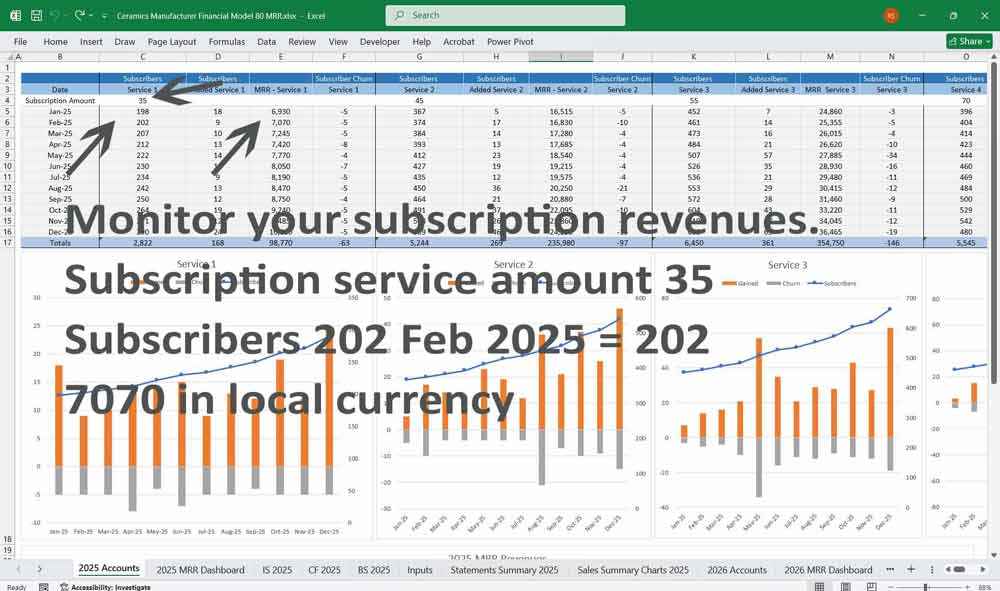
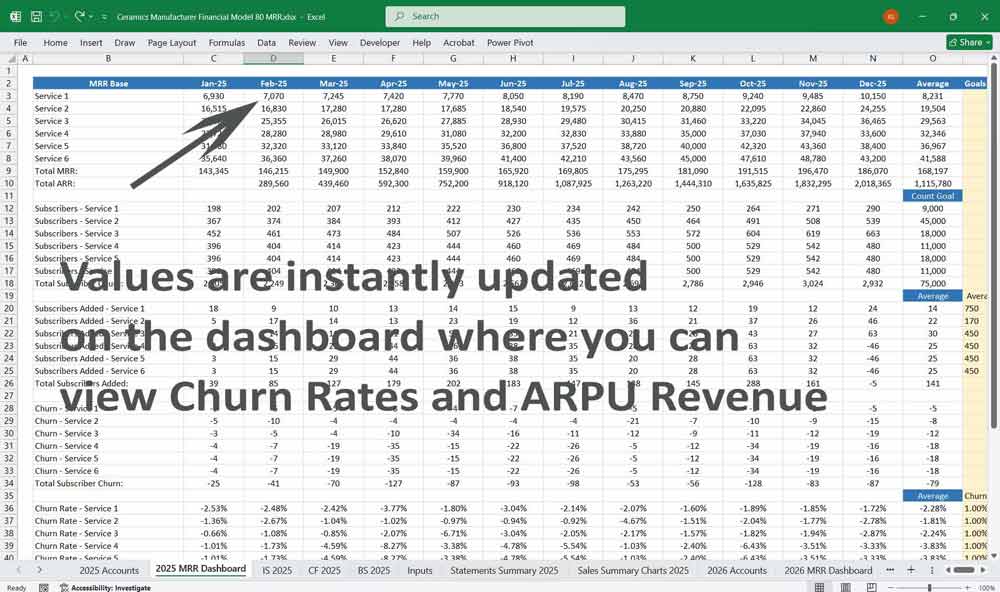
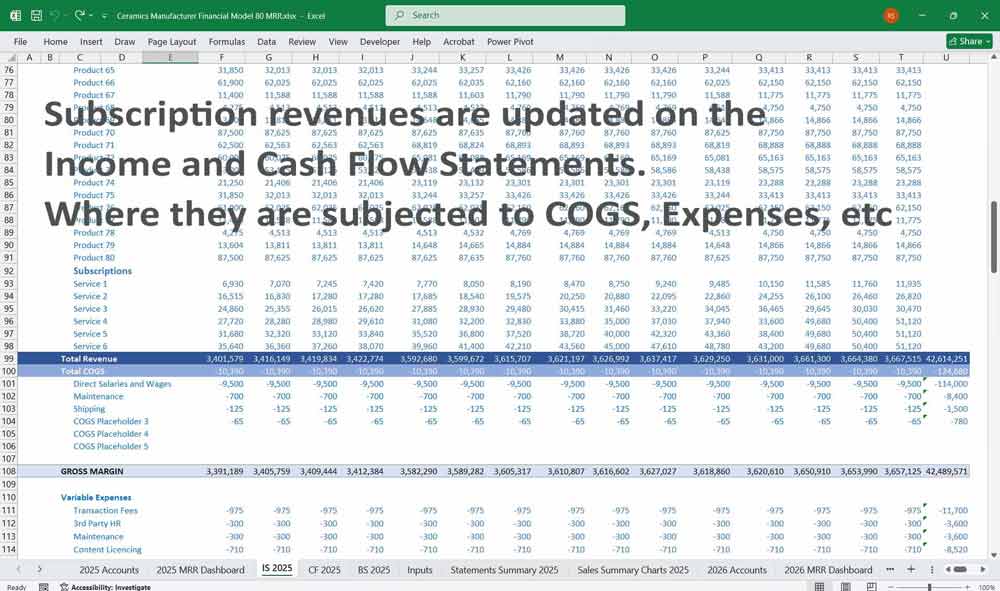
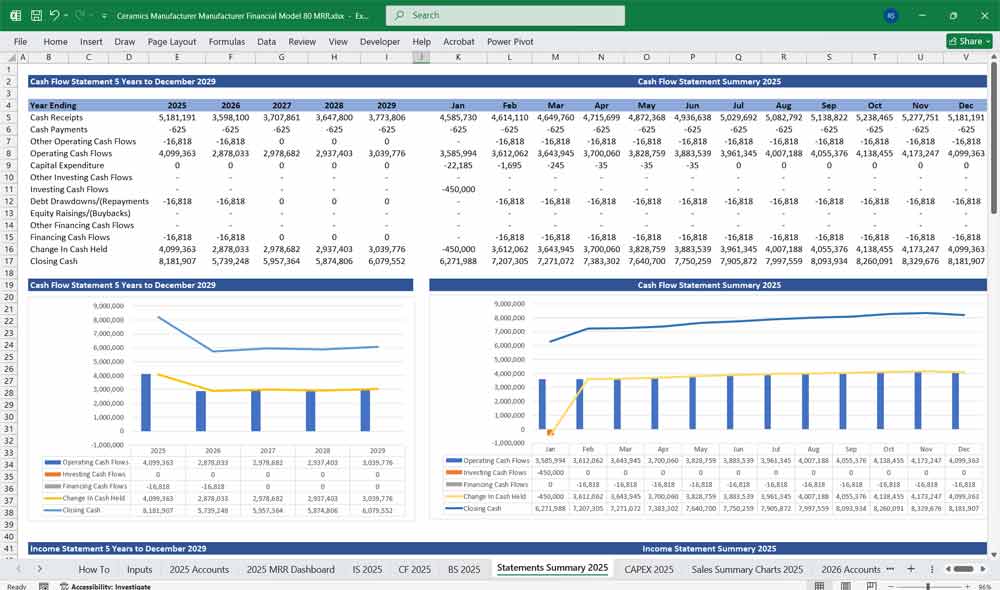
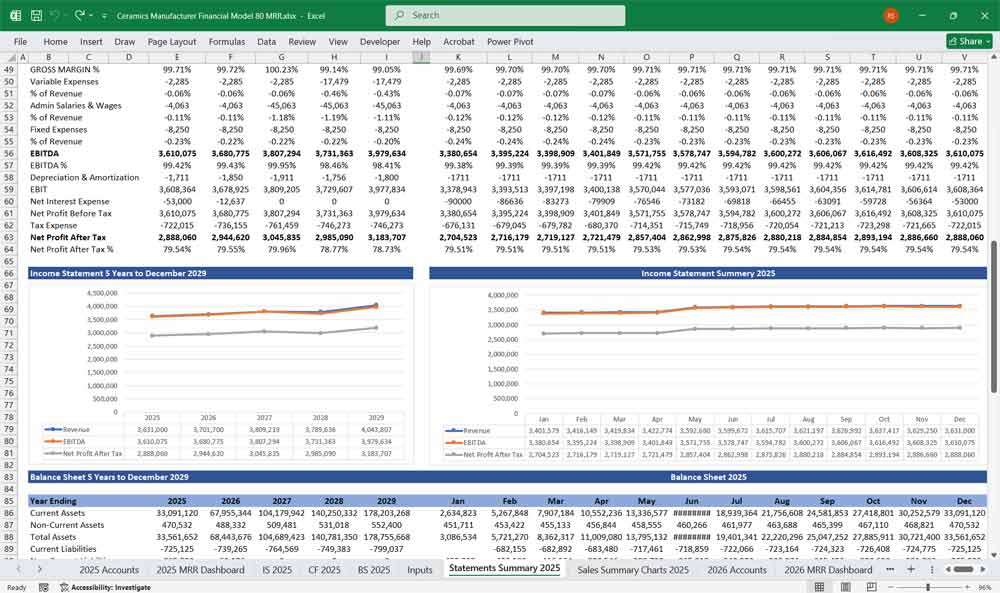
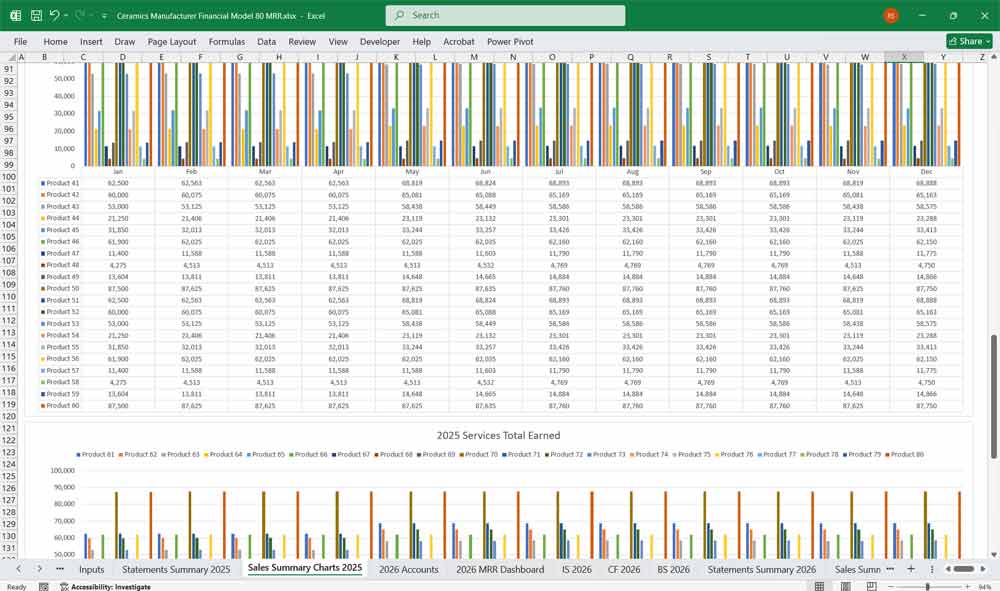
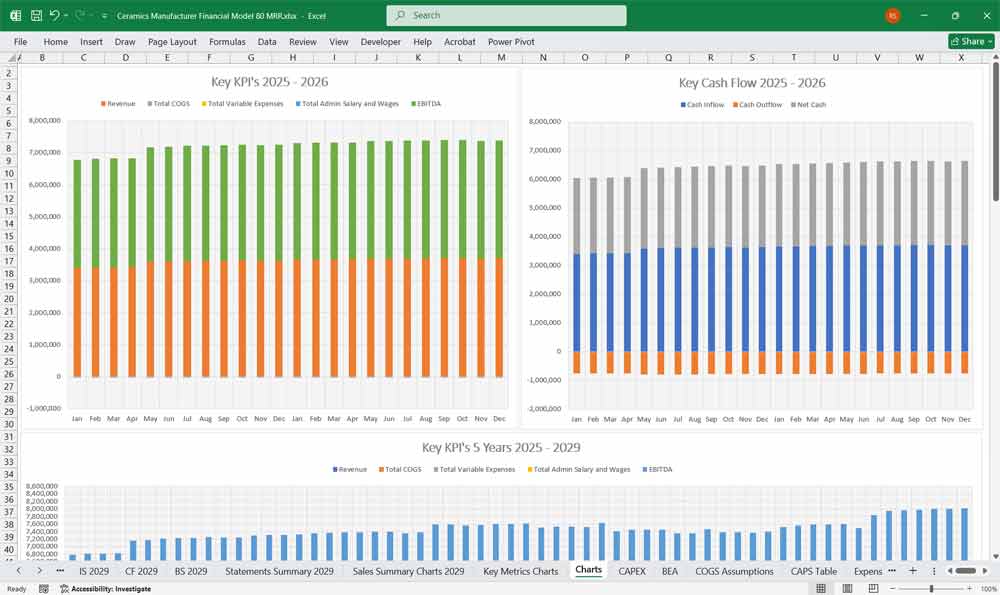
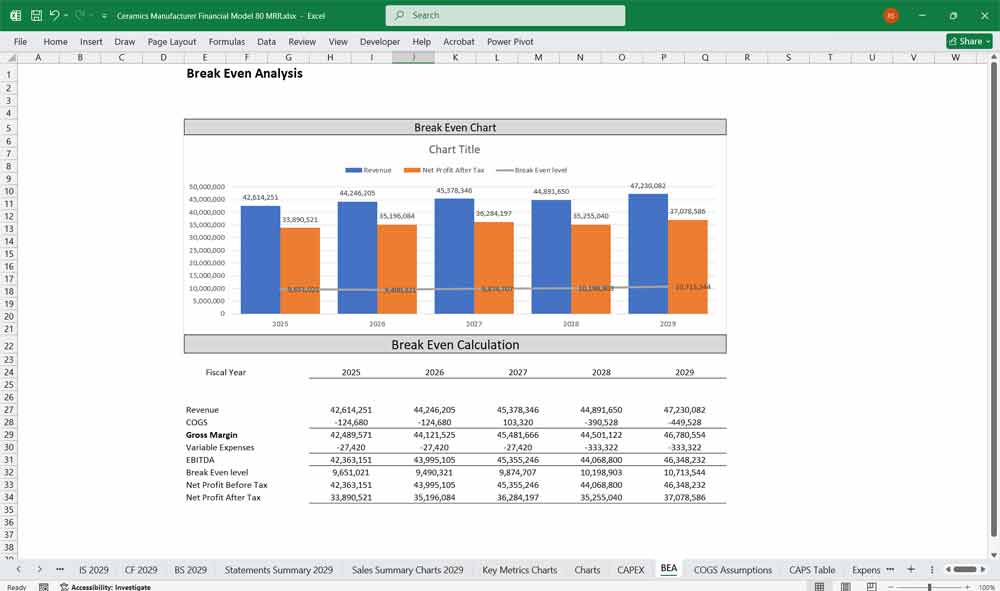
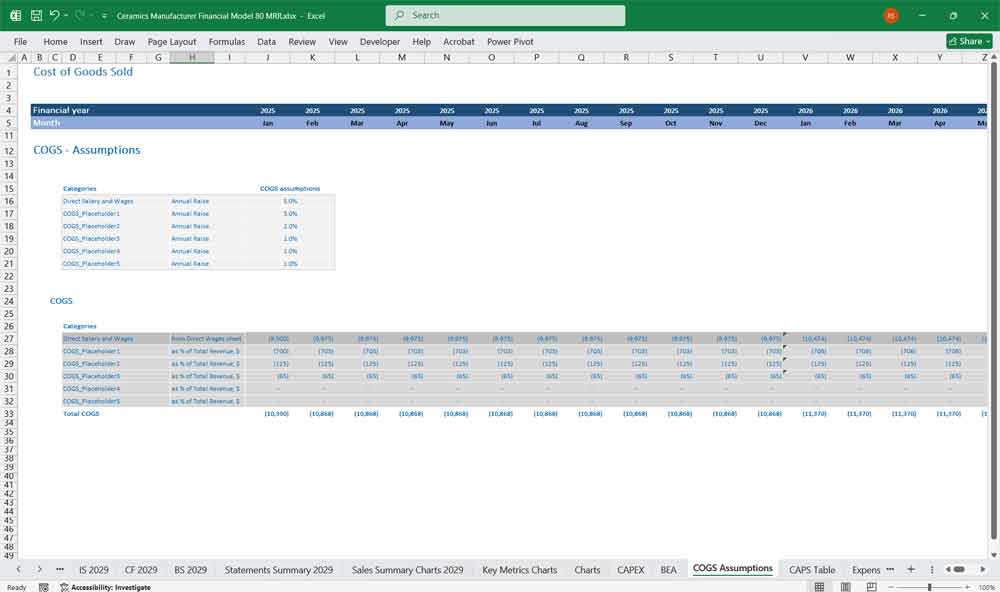
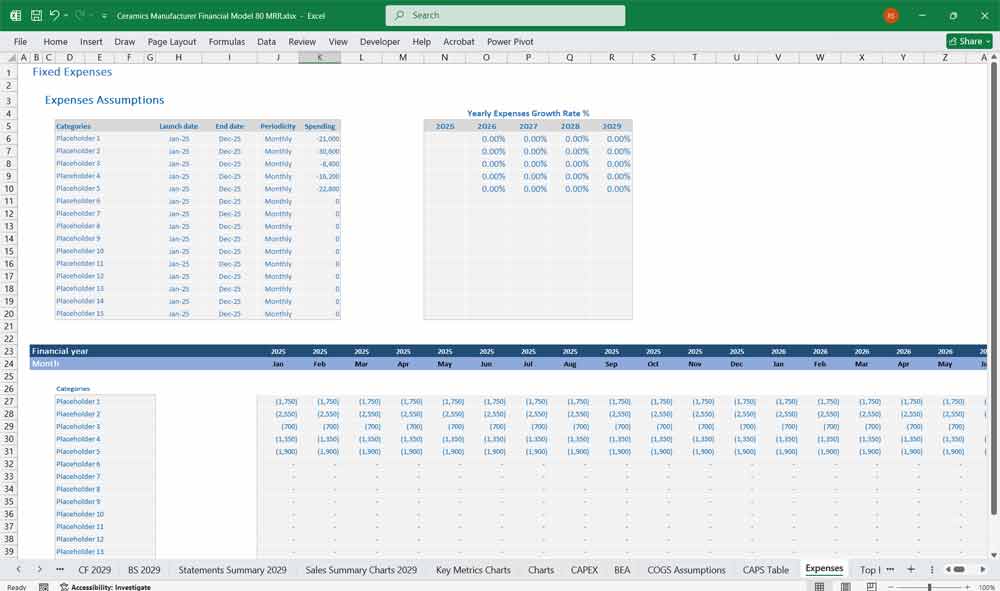
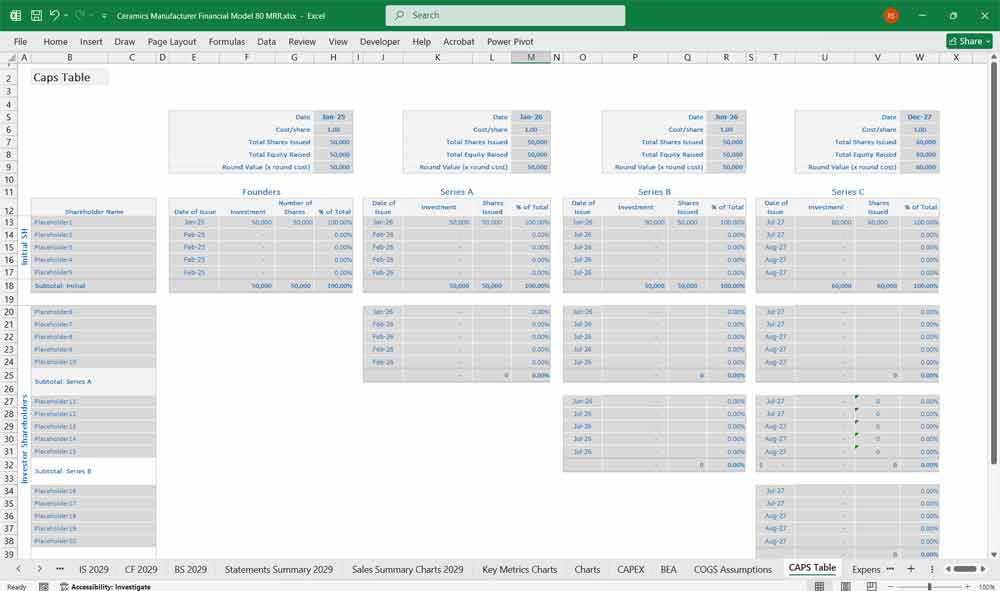
Financial Dashboard and KPIs
- Product Metrics:
- Revenue per product line (80-line comparison).
- Average cost-per-unit analysis.
- Subscription Metrics:
- Revenue growth by tier adoption rate.
- Average subscription upgrade frequency.
- Profitability Metrics:
- Contribution margin by subscription tier.
- Machine setup utilization: Jobs completed vs. capacity.
- Operational Metrics:
- On-time delivery rate for ceramic parts.
- Inventory turnover ratios.
Final Notes on the Financial Model
Financial model for a Ceramics manufacturer
- Scenario Analysis: Create best-case, base-case, and worst-case projections.
- Break-even Analysis: Determine the sales volume required to cover fixed & variable costs.
- Sensitivity Analysis: Assess how changes in raw material costs, pricing, or demand impact profitability.
These structured models and other financial templates will help any ceramics manufacturing company address a broad market spectrum, offering the right balance between cost, production capacity, and support.
Download Link On Next Page
